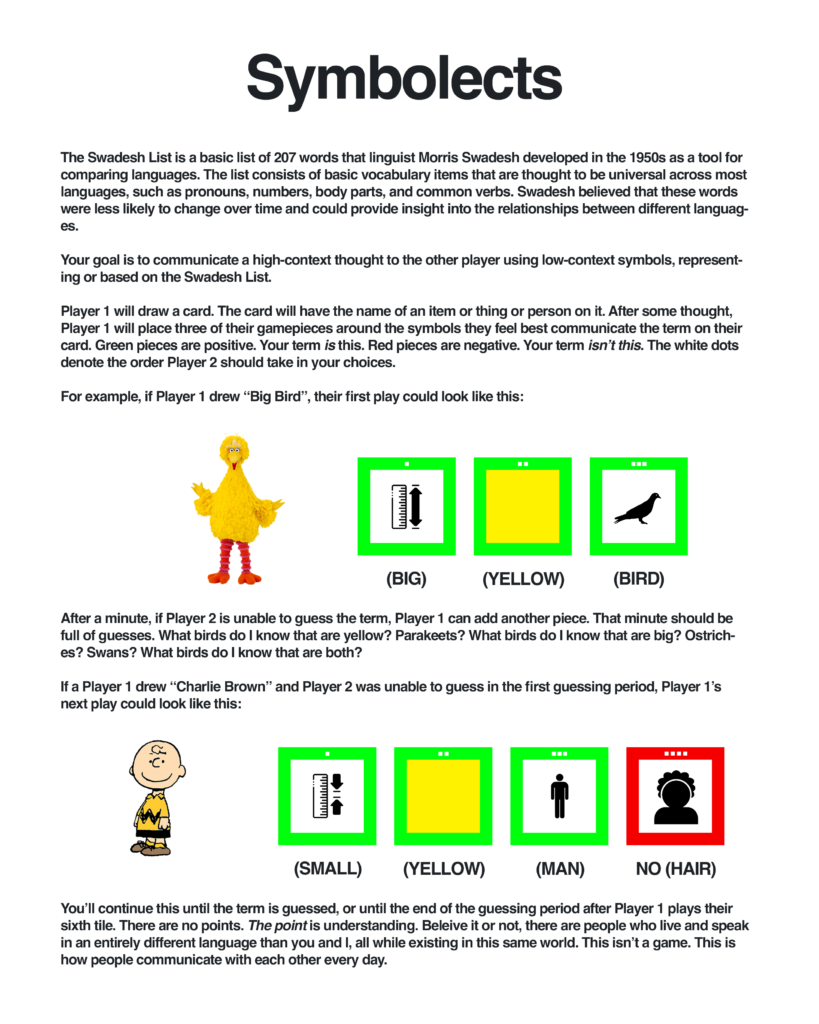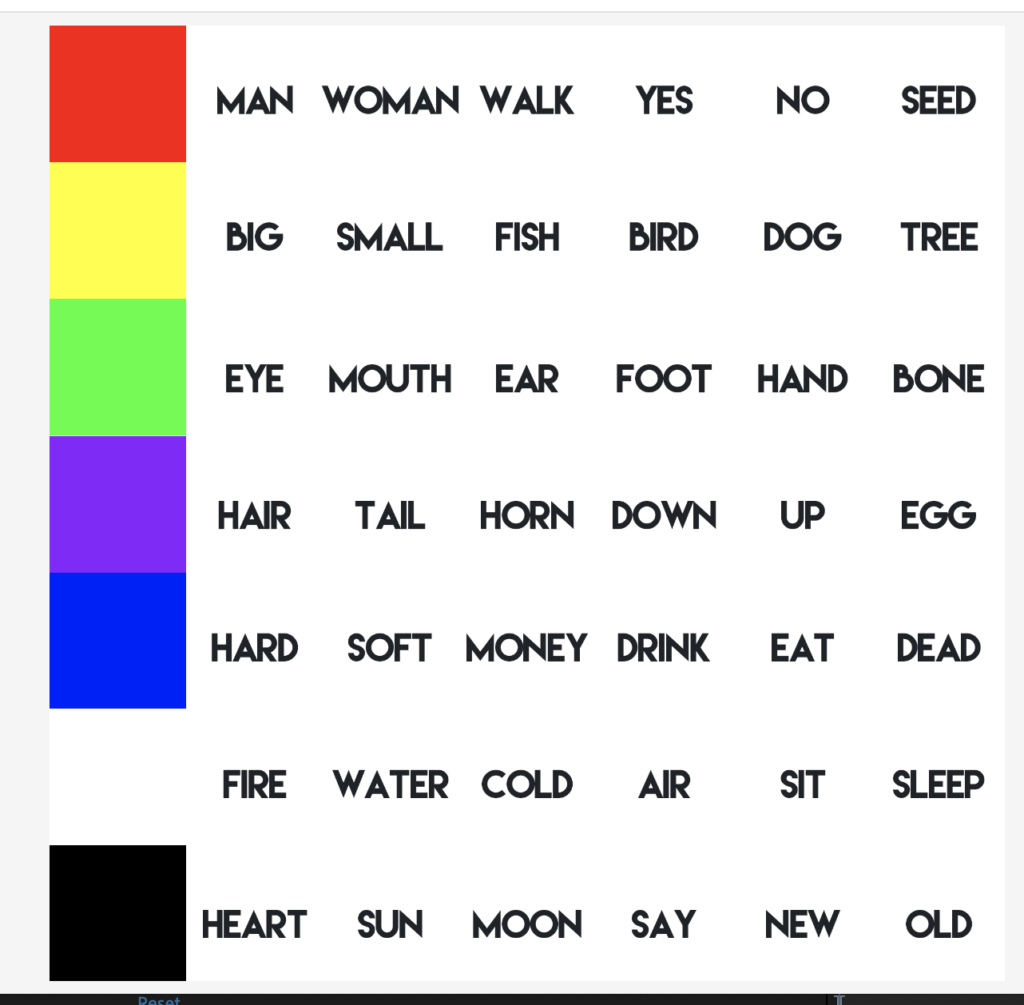
Symbolects

This was when I started the game.

Originally I wanted the markers to look like little highlighted bubbles, and for a few people to be able to play markers per round.
That was not nearly enough symbols to convey anything fun.

I moved up to 7×7. I think the strongest additions were the body parts.

I did want to see if terms rather than symbols could help, but in actually playing the game, the ambiguity of the symbols allowed them to – interestingly enough – symbolize more than just one word.
I still wanted more symbols.

This is the final board. At least digitally. I thought the mixed up version would look a lot cooler, but having the semi-related symbols by each other did help out. At least in terms of finding the right symbol for what you wanted to express.

The final markers work as “are”s and “aren’t”s. Can you guess which is which? You get to place 6 for any one term.
Soul Mental Health Campaign 2
This week, I thought I would try to test mechanics for my setting. I drafted a few characters with different mental health diagnoses, and each one gave a different debuff to that character.
Depression: +2 fatigue starting, +1 fatigue on failure.
Anxiety: +2 fatigue on failure. +1 fatigue on success to a random stat. Reaching max fatigue in a stat causes +3 fatigue in 2 random stats.
ADHD: cannot attempt the same thing more than twice in a row without trying something else. Any time a switch is made, +1 fatigue to the previously attempted stat.
Results:
These debuffs relied heavily on the implementation to work the way they did. I may end up scrapping this idea and go with a narrative driven game instead. This had, perhaps due to my modern day framing, perhaps due to mechanics, a bit too much of the desired effect. Players became less interested in trying to play these characters because they felt it too difficult to make meaningful progress.
Soul Mental Health Campaign Test 1
For this version of the game, I had to rework how non-combat encounter rolls work. Originally, if you failed a roll, that was it, but since I am not going to be present to GM that, I need a mechanic to determine what happens if you don’t succeed.
I decided that when you roll vs the difficulty of an encounter, If you fail by greater than 50 under the required value, this constitutes a critical failure. If you succeed by greater than 50, this constitutes a critical success. This, for our purposes, affects fatigue, which is how tired your character is of trying the thing they’re doing, and it will penalize the stat you’re trying to use until that hits 0.
When you fail, you get 1 fatigue, and -1. When you crit fail, you get 3 fatigue, and -3.
Success means you get to continue. critical success probably won’t have an effect here.
Results:
This system works well in a structured, GM present game. That said, I’ll be interested to try it with my setting in mind and with me absent.
Week 2 Game thoughts
Pepsi man is fantastic. No flaws.
Chex quest is an interesting game, because it is just a doom fork with well, a fork instead of a shotgun. I can see the appeal to people who don’t have doom, but I also think it would wear off in a matter of seconds after starting the game.
M&M kart racing is a terrible game. This is like minimalist mario kart if you had a nail in all four tires and your engine. The tracks are empty, no life or heart in anything, just corporate shovelware.
America’s Army, say what you will, is actually kind of fun. It’s definitely meant to glamourize the armed forces, but that being said, It is also an entertaining FPS. It doesn’t compare well to things we have today, but for what it is, it’s decent.
Week 3 Game Thoughts
Dumb ways to die is a fun little game with a lot of interesting challenges, but it gets old quick and it’s not necessarily a varied experience.
Cards against calamity has a cool name that indicates it will be a parody of an established popular game, but it is quite boring. That said, it gets the point across and even easy difficulty is challenging.
Cast your vote is the epitome of shovelware. This game has barely any actual gameplay elements whatsoever. This is digitized voter preparation, and it is even less glamorous than people perceive the real thing to be.
Problems That Can be Addressed With Games
- Climate Change
- Money Spending Habits
- Student Loan Debt
- Understanding Mental Health
- The Switch to Electric Cars
Game Ideas: Games that Matter
- Sinking feeling is a game about rising sea levels, where players have to collect cards to beat back the rising tides assaulting their homes
- Coral grief is a game about the dying coral reefs in many parts of the world. This game has players take control of a group of scientists tasked with protecting a reef, but during their journey around the board, they will have to contend with all the obstacles and dangers involved in these delicately balanced ecosystems.
- Mental Health Campaign: a literal campaign for a Pen and Paper RPG, meant to raise awareness of mental health and grief.
- Hotter potato: a game where players have to take turns providing solutions to ever more difficult climate related problems as the clock runs down.
- Just Write: A game that attempts to improve appreciation and quality of good writing from an objective standpoint.
Game Ideas: Games that don’t end
- Afterlife: a game that simulates your character’s life and faith, and after you die, depending on your decisions and perhaps your faith, you get a screen that simply remains up forever until closed by force. This simply displays the afterlife.
- And then: A game where people take turns telling a story that makes sense for as long as they can, but may only add one sentence at a time, and every sentence after the first must begin with, “and then.”
- A game inspired by the infamous, “the game” which I have now lost, and so have you, but focused on a specific topic or item. When someone thinks of the forbidden noun, they must declare they have thought of the forbidden noun, and then announce a new noun. Then, the game begins again.
- A game where you continue to build a tower. Each level costs more money, which you can make by furnishing and renting the lower levels of your tower.
- And yet it burns, a game where the only objective is to remember that the piece of paper I lit during a doodle war 15 years ago continues to burn, putting pressure on Taylor’s character to make his move. Every now and again, simply remember and state that, it does indeed, yet burn.
Who’s That Artist? Podcast Ep. 1
What’s going on guys. Just a brief overview on the podcast linked to this post. Through it, although not too long of a listen, I give a background and comparison between three artists: Natalie Bookchin, Wafaa Bilal, and Rafael Farjardo. Hope you enjoy!
What would I have changed? (Post-Final)
After the final day of class, there are still things I hope to improve, or wanted to do that I didn’t get around to doing. My initial idea for a ruleset was to provide the players with a better experience via a video version of the game being played. They would open the card game box, and on the inside of the box would be a QR-code that they could scan and watch a video on the rules of BrainyAct, rather than reading through a bunch of boring words. Also, the final version of the cards came out pretty well, but two things I wanted to change. One was the finish on the cards, or the physical feel of them. I wanted them to be heavier, and almost metallic which I can still do. And second, I wanted to take the feedback from my testers and expand on the design of the card on the front of the card where the question is. I think I can still work on this; I can definitely see this game being played by people around the world.
Final Class Notes
Today marked the final class. Although not much to talk about, I did end up making minor changes to BrainyAct to provide for a better experience. I ended up printing a graphic for the rule set with the brain pattern on the back of the card onto a full sheet of paper for the ruleset. I went into photoshop and put the ruleset on top of a lowered opacity brain pattern to provide with easier legibility. Overall, I think the feedback was great, and plan on revising and improving the game still.
Brenda Romero & Will Wright Podcast
Pollinator 3.0
Brought to you by River and Ronan. Collaboration of the Century.
Thoughts on Dumb Ways to Die, Fake it to Make it, Cards against Calamity, and Cast your vote
Though I couldn’t be in class to play these games, I did do some research and played them on my own. I like the idea that these games exist as both a form of entertainment and also as a way to educate people on important topics. For example, Fake it to Make It and Cast your vote both create an entertaining game experience by teaching players why it is important to recognize fake news, as well as the importance of voting. Providing players with an educational experience that is fun will greatly increase their likelihood of taking action later, like actually voting and actually monitoring the information they are being given by the media.
Dumb ways to Die takes a more entertainment-based approach by cartoonizing death and other serious injury as a form of PSA against taking part in those activities. I don’t know if I would personally call Dumb Ways to Die educational, but it’s not not educational, I guess. Overall, This lineup of games is a fun contrast to purely entertainment-focused games and can provide a real transformative and fun educational experience that likely makes people way more excited to learn about otherwise incredibly boring topics.
